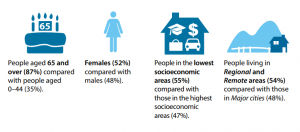What are the facts?
About half of all Australians have a chronic disease, and around 20 per cent (%) have at least two, according to new data from the Australian Institute of Health and Welfare (AIHW).
AIHW has said that this can purely be by chance, but there are often associations between diseases, such as shared risk factors.
What is a chronic disease?
Chronic diseases, also known as non-communicable diseases, are long-term health conditions which usually develop slowly and are potentially preventable.
To simplify, The World Health Organisation (WHO) focuses primarily on four major disease groups:
- Cardiovascular diseases
- Cancers
- Chronic obstructive pulmonary disease (COPD)
WHO recognises that many different illnesses and health conditions can be classified under the broad heading of chronic disease.
They often coexist, share common risk factors and are increasingly seen as acting together in the way they determine the health status of individuals.
Risk factors
Occurrence of chronic diseases increases with age, however many chronic diseases also share common risk factors which are largely preventable.
Risk factors include:
- Smoking
- Physical inactivity
- Poor nutrition
- Harmful use of alcohol
- Illicit drug use.
Lifestyle choices have a huge impact on the risk of developing chronic disease; an estimated 31% of the burden of disease in Australia could have been prevented by reducing the above listed risk factors.
Common chronic diseases in Australia
Chronic diseases such as cancer, coronary heart disease and diabetes are becoming increasingly common in Australia due to our ageing population, as well as social and lifestyle changes.
Based on self-reported data, cardiovascular disease (18%) and mental health conditions (18%) were the most commonly reported of the selected chronic diseases in Australia, followed by back pain and back problems (16%).
Who suffers from chronic disease?
In 2014–15, more than 11 million Australians (50%) reported having at least one of the eight selected chronic diseases. This rate was higher for:
Source: AIHW
Mortality
Changes to our lifestyles and reduction in other diseases over the last 100 years have meant chronic diseases are becoming increasingly common.
Chronic diseases are the leading cause of illness, disability and death in Australia, accounting for 90% of all deaths in 2011.
They can have large impacts on quality of life as well as social and economic effects.
Disease burden in Australia
In addition to personal and community costs, chronic diseases result in a significant economic burden because of the combined effects of healthcare costs and lost productivity from illness and death.
Estimates based on allocated health care expenditure indicate the four most expensive disease groups are:
- Chronic cardiovascular diseases
- Oral health
- Mental disorders
These four groups incurred direct health-care costs of $27 billion in 2008–09. This equates to 36% of all allocated health expenditure.
Can chronic disease be prevented?
Many chronic diseases share common conditions or risk factors that relate to your everyday choices and personal health habits. Modifying these can reduce the risk of developing a chronic condition, leading to large health gains in the population through the reduction of illness and rates of death.
The big four chronic diseases are among the most preventable. By making healthier choices you can lower your risk of developing the disease. You can choose to:
- Be a non-smoker and avoid second hand smoke
If you smoke, get help to quit. Smoking is the major cause of Chronic Obstructive Pulmonary Disease (COPD) and lung cancer. It is also a major risk factor for heart attack and stroke. It’s never too late to quit and reduce your risk.
- Maintain physical activity daily
Physical activity can help you control your weight and boost your energy levels. A minimum of 30 minutes a day can have immediate and long-term health benefits. Doing any physical activity is better than doing none. If you currently do no physical activity, start by doing some, and gradually build up to the recommended amount.
- Drop the junk food and eat healthily
Following a healthy, balanced diet can help you to maintain a healthy weight, lower your cholesterol and reduce your risk of disease. Avoid foods loaded with sodium, sugar and fat and instead opt for high fibre, lower fat foods. Aim to get 5-10 servings of fruit and vegetables every day.
Being overweight increases your risk of diabetes, heart disease and even some cancers. The risk of a heart attack is three times higher in women who are overweight than in those who have a healthy weight. Talk to your healthcare provider to determine your personal healthy weight and work out a plan for achieving or maintaining it.
- Control your blood pressure
Keeping your blood pressure in check can help prevent damage to the walls of your arteries like tears and bulges and possibly slow the hardening of your arteries. Have your blood pressure checked regularly by your healthcare provider and follow your management directions.
- Limit your intake of alcohol
Drinking too much alcohol can put you at risk of developing many kinds of cancer. Aim to stick to a moderate level of drinking, if at all. Moderate drinking means an average of one drink for women or two drinks for men per day.
- Reduce your stress
Take time to relax. Stress can raise your cholesterol level and blood pressure and lead to heart attack and stroke. Stress is also a trigger for mental health problems like depression. See your healthcare provider for help in managing stress.
- Ensure you are screened and tested regularly.
Know your body and report any new signs and symptoms to your healthcare provider. Ensure your blood pressure, cholesterol and blood sugar levels are checked regularly by your GP. In many cases, the earlier a problem is detected, the easier it is to treat.






